Change Management Strategies and Implementation at HSBC
VerifiedAdded on 2022/08/20
|11
|3402
|277
Report
AI Summary
This report provides a comprehensive analysis of change management within HSBC. It begins by identifying the key drivers for change, including economic recession, fluctuating market trends, and technological advancements. The report then details the measures taken by HSBC's management to overcome resistance to change, such as the implementation of the 'Managing for Value' strategy, the development of a four-step model, employee education initiatives, and the 'Together We Win' campaign. The application of Kotter's change management model and the use of video activities are also discussed. Furthermore, the report examines HSBC's commitment to the triple bottom line, integrating social, environmental, and economic considerations. The report highlights the importance of employee engagement, organizational culture, and continuous improvement in driving successful change initiatives. The strategies were successful as it acquainted the employees with the advantages of the new strategy that helped in convincing the employees about the effectiveness of the new strategy.
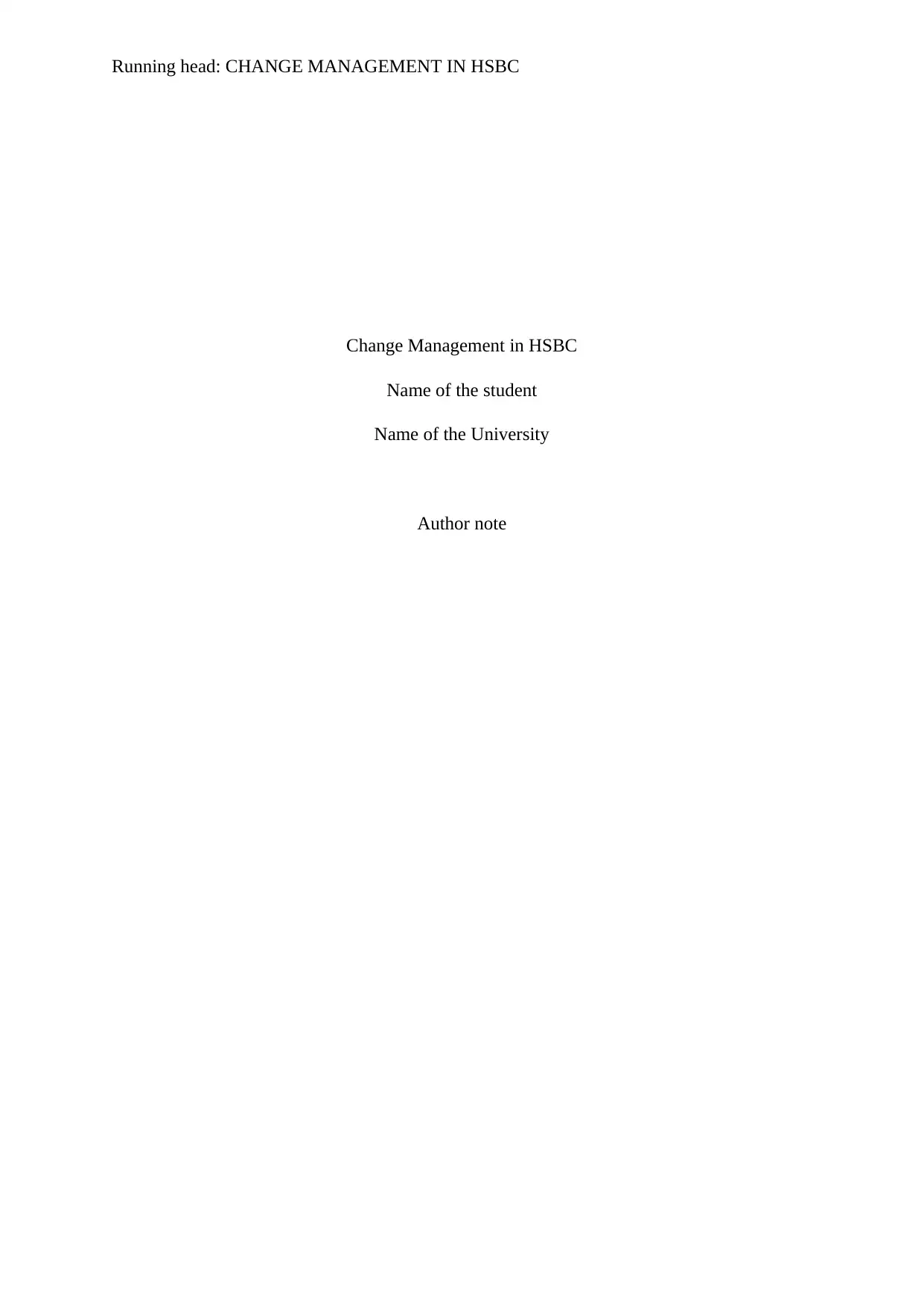
Running head: CHANGE MANAGEMENT IN HSBC
Change Management in HSBC
Name of the student
Name of the University
Author note
Change Management in HSBC
Name of the student
Name of the University
Author note
Paraphrase This Document
Need a fresh take? Get an instant paraphrase of this document with our AI Paraphraser
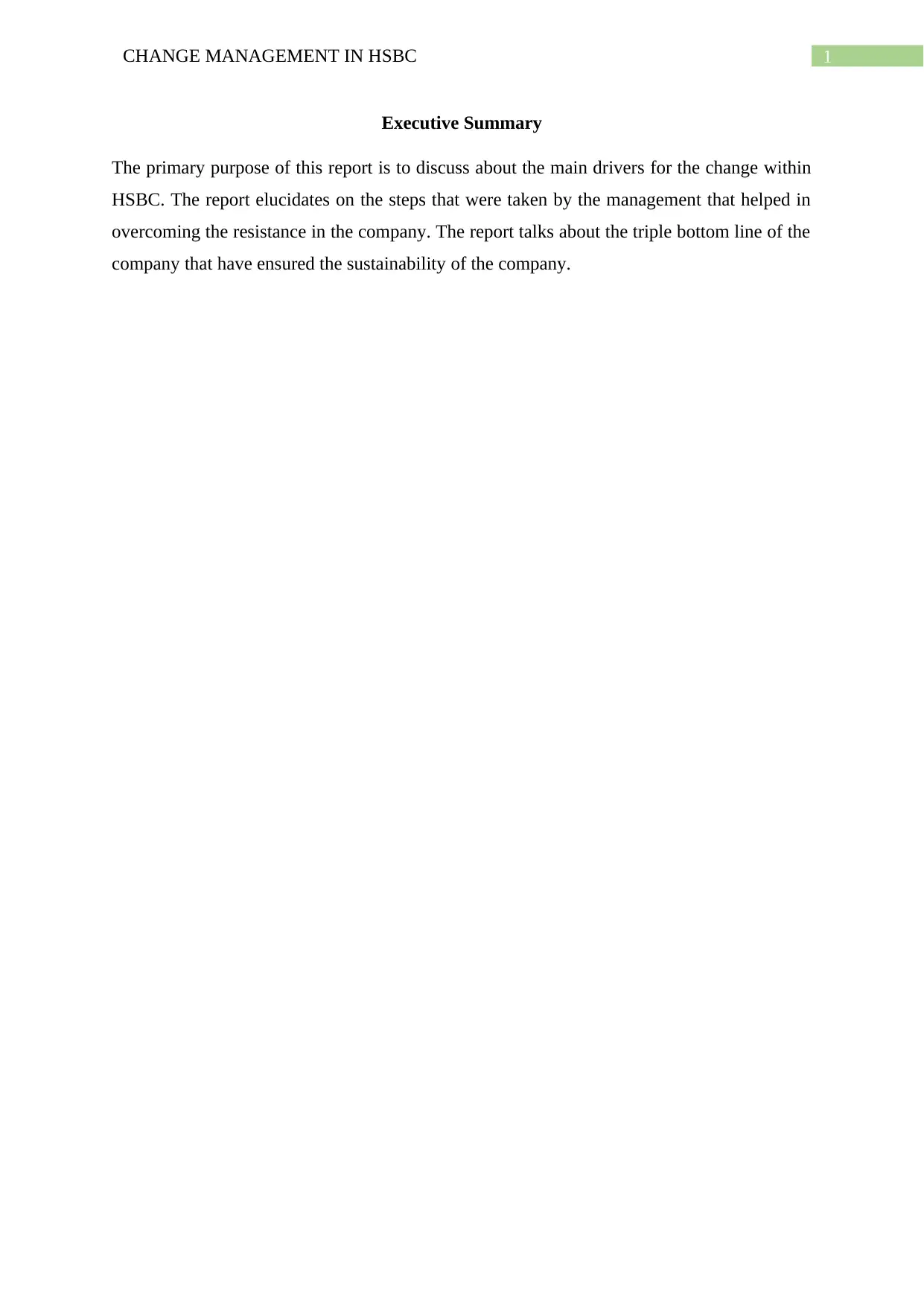
1CHANGE MANAGEMENT IN HSBC
Executive Summary
The primary purpose of this report is to discuss about the main drivers for the change within
HSBC. The report elucidates on the steps that were taken by the management that helped in
overcoming the resistance in the company. The report talks about the triple bottom line of the
company that have ensured the sustainability of the company.
Executive Summary
The primary purpose of this report is to discuss about the main drivers for the change within
HSBC. The report elucidates on the steps that were taken by the management that helped in
overcoming the resistance in the company. The report talks about the triple bottom line of the
company that have ensured the sustainability of the company.
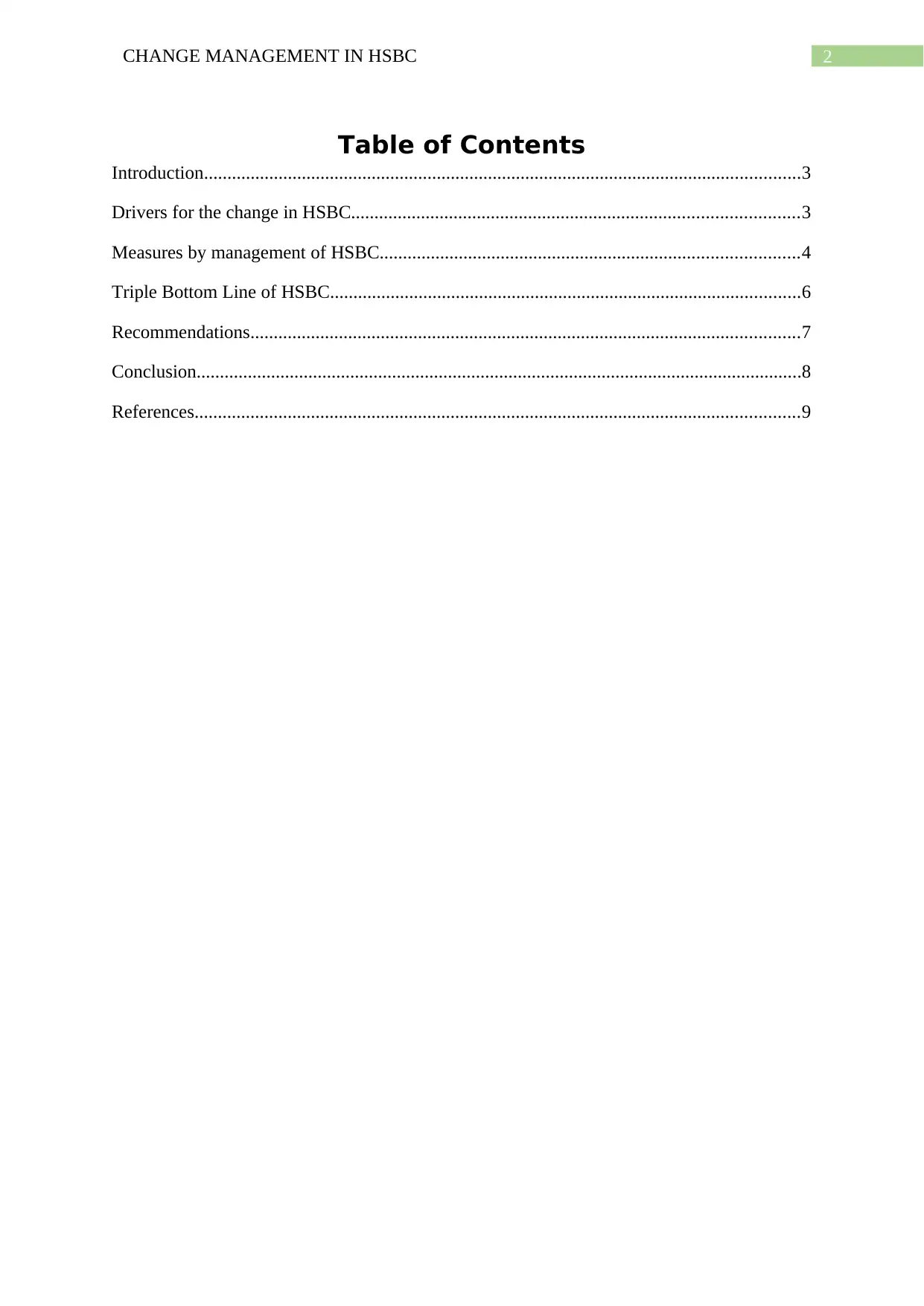
2CHANGE MANAGEMENT IN HSBC
Table of Contents
Introduction................................................................................................................................3
Drivers for the change in HSBC................................................................................................3
Measures by management of HSBC..........................................................................................4
Triple Bottom Line of HSBC.....................................................................................................6
Recommendations......................................................................................................................7
Conclusion..................................................................................................................................8
References..................................................................................................................................9
Table of Contents
Introduction................................................................................................................................3
Drivers for the change in HSBC................................................................................................3
Measures by management of HSBC..........................................................................................4
Triple Bottom Line of HSBC.....................................................................................................6
Recommendations......................................................................................................................7
Conclusion..................................................................................................................................8
References..................................................................................................................................9
⊘ This is a preview!⊘
Do you want full access?
Subscribe today to unlock all pages.

Trusted by 1+ million students worldwide
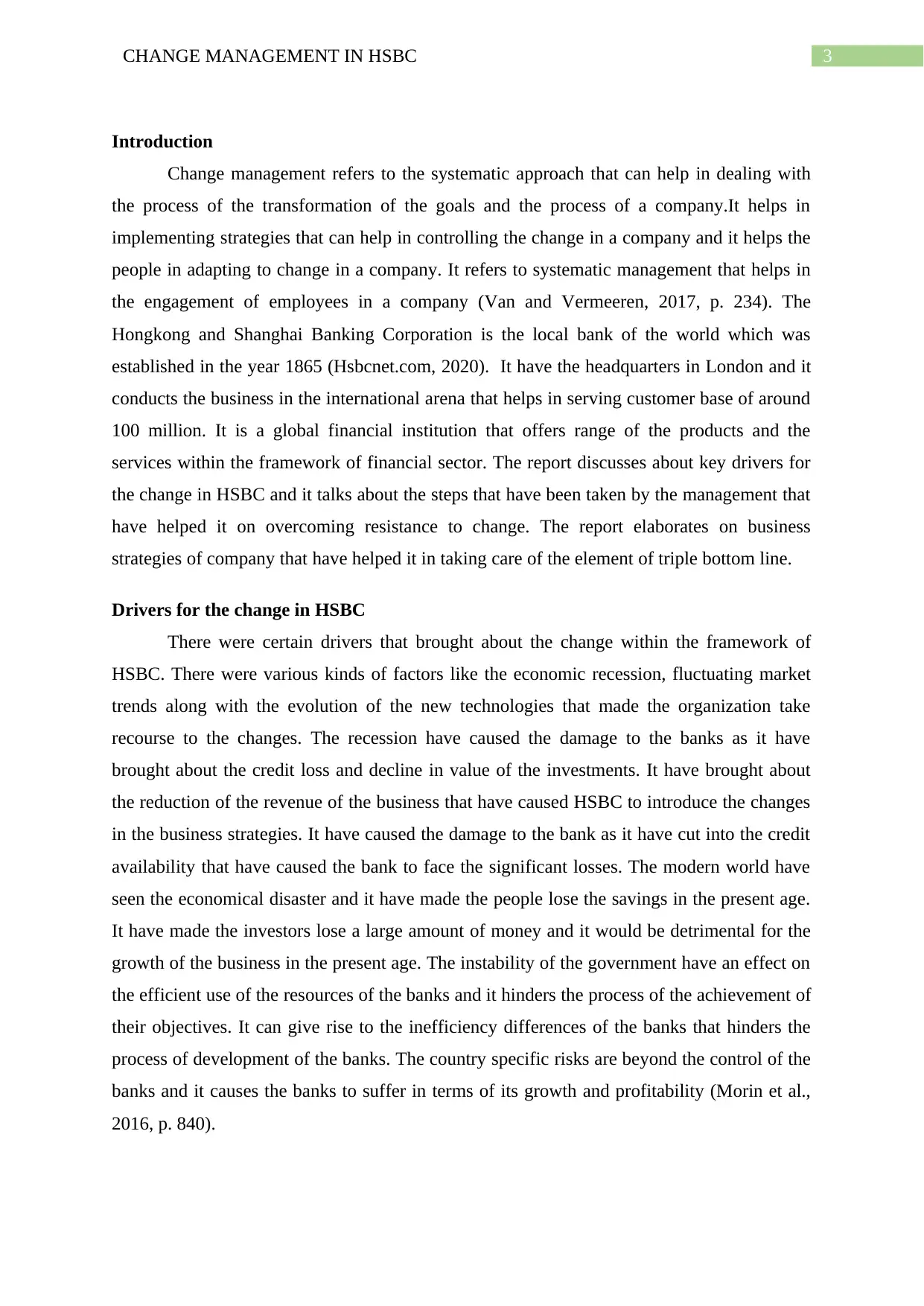
3CHANGE MANAGEMENT IN HSBC
Introduction
Change management refers to the systematic approach that can help in dealing with
the process of the transformation of the goals and the process of a company.It helps in
implementing strategies that can help in controlling the change in a company and it helps the
people in adapting to change in a company. It refers to systematic management that helps in
the engagement of employees in a company (Van and Vermeeren, 2017, p. 234). The
Hongkong and Shanghai Banking Corporation is the local bank of the world which was
established in the year 1865 (Hsbcnet.com, 2020). It have the headquarters in London and it
conducts the business in the international arena that helps in serving customer base of around
100 million. It is a global financial institution that offers range of the products and the
services within the framework of financial sector. The report discusses about key drivers for
the change in HSBC and it talks about the steps that have been taken by the management that
have helped it on overcoming resistance to change. The report elaborates on business
strategies of company that have helped it in taking care of the element of triple bottom line.
Drivers for the change in HSBC
There were certain drivers that brought about the change within the framework of
HSBC. There were various kinds of factors like the economic recession, fluctuating market
trends along with the evolution of the new technologies that made the organization take
recourse to the changes. The recession have caused the damage to the banks as it have
brought about the credit loss and decline in value of the investments. It have brought about
the reduction of the revenue of the business that have caused HSBC to introduce the changes
in the business strategies. It have caused the damage to the bank as it have cut into the credit
availability that have caused the bank to face the significant losses. The modern world have
seen the economical disaster and it have made the people lose the savings in the present age.
It have made the investors lose a large amount of money and it would be detrimental for the
growth of the business in the present age. The instability of the government have an effect on
the efficient use of the resources of the banks and it hinders the process of the achievement of
their objectives. It can give rise to the inefficiency differences of the banks that hinders the
process of development of the banks. The country specific risks are beyond the control of the
banks and it causes the banks to suffer in terms of its growth and profitability (Morin et al.,
2016, p. 840).
Introduction
Change management refers to the systematic approach that can help in dealing with
the process of the transformation of the goals and the process of a company.It helps in
implementing strategies that can help in controlling the change in a company and it helps the
people in adapting to change in a company. It refers to systematic management that helps in
the engagement of employees in a company (Van and Vermeeren, 2017, p. 234). The
Hongkong and Shanghai Banking Corporation is the local bank of the world which was
established in the year 1865 (Hsbcnet.com, 2020). It have the headquarters in London and it
conducts the business in the international arena that helps in serving customer base of around
100 million. It is a global financial institution that offers range of the products and the
services within the framework of financial sector. The report discusses about key drivers for
the change in HSBC and it talks about the steps that have been taken by the management that
have helped it on overcoming resistance to change. The report elaborates on business
strategies of company that have helped it in taking care of the element of triple bottom line.
Drivers for the change in HSBC
There were certain drivers that brought about the change within the framework of
HSBC. There were various kinds of factors like the economic recession, fluctuating market
trends along with the evolution of the new technologies that made the organization take
recourse to the changes. The recession have caused the damage to the banks as it have
brought about the credit loss and decline in value of the investments. It have brought about
the reduction of the revenue of the business that have caused HSBC to introduce the changes
in the business strategies. It have caused the damage to the bank as it have cut into the credit
availability that have caused the bank to face the significant losses. The modern world have
seen the economical disaster and it have made the people lose the savings in the present age.
It have made the investors lose a large amount of money and it would be detrimental for the
growth of the business in the present age. The instability of the government have an effect on
the efficient use of the resources of the banks and it hinders the process of the achievement of
their objectives. It can give rise to the inefficiency differences of the banks that hinders the
process of development of the banks. The country specific risks are beyond the control of the
banks and it causes the banks to suffer in terms of its growth and profitability (Morin et al.,
2016, p. 840).
Paraphrase This Document
Need a fresh take? Get an instant paraphrase of this document with our AI Paraphraser
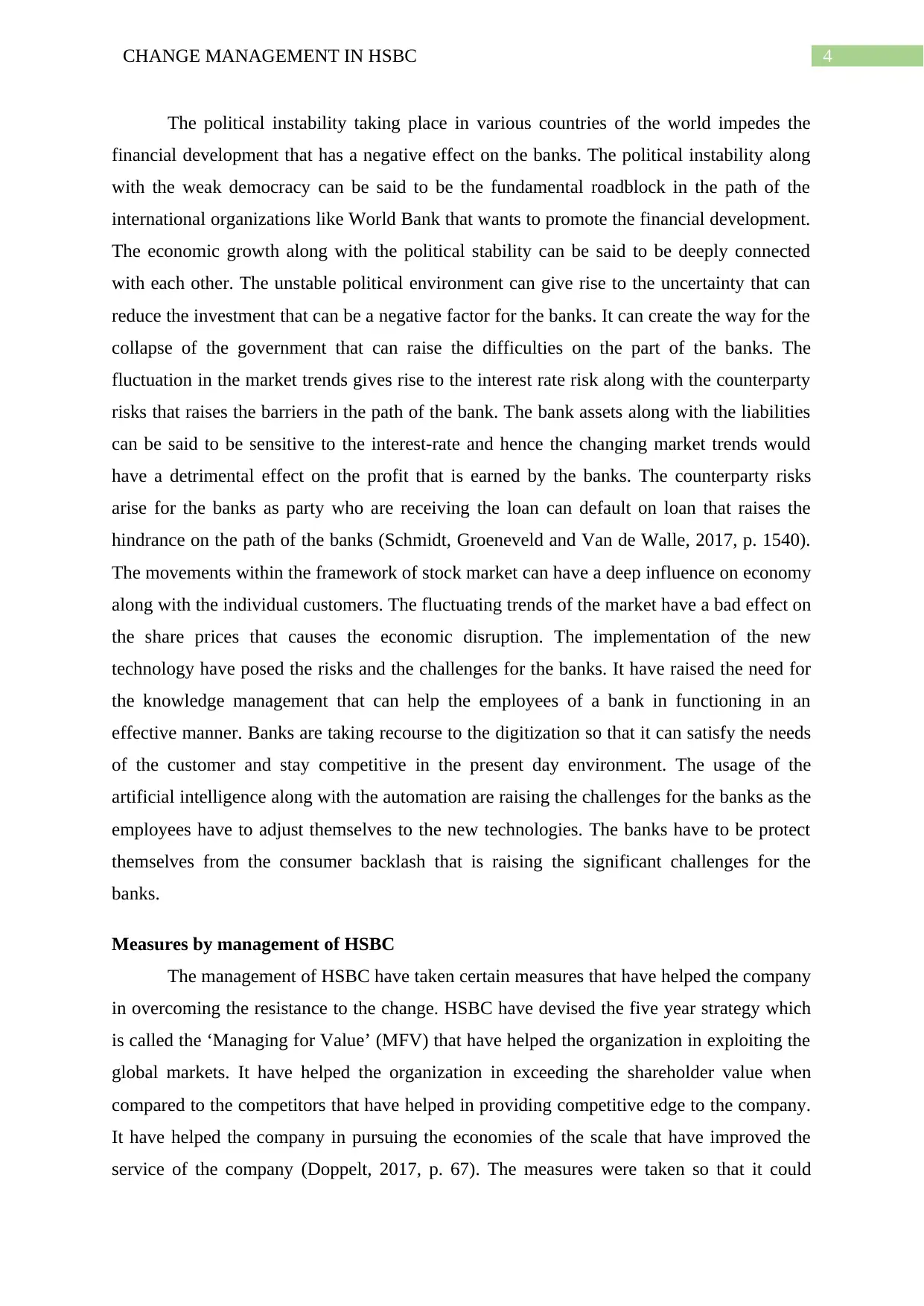
4CHANGE MANAGEMENT IN HSBC
The political instability taking place in various countries of the world impedes the
financial development that has a negative effect on the banks. The political instability along
with the weak democracy can be said to be the fundamental roadblock in the path of the
international organizations like World Bank that wants to promote the financial development.
The economic growth along with the political stability can be said to be deeply connected
with each other. The unstable political environment can give rise to the uncertainty that can
reduce the investment that can be a negative factor for the banks. It can create the way for the
collapse of the government that can raise the difficulties on the part of the banks. The
fluctuation in the market trends gives rise to the interest rate risk along with the counterparty
risks that raises the barriers in the path of the bank. The bank assets along with the liabilities
can be said to be sensitive to the interest-rate and hence the changing market trends would
have a detrimental effect on the profit that is earned by the banks. The counterparty risks
arise for the banks as party who are receiving the loan can default on loan that raises the
hindrance on the path of the banks (Schmidt, Groeneveld and Van de Walle, 2017, p. 1540).
The movements within the framework of stock market can have a deep influence on economy
along with the individual customers. The fluctuating trends of the market have a bad effect on
the share prices that causes the economic disruption. The implementation of the new
technology have posed the risks and the challenges for the banks. It have raised the need for
the knowledge management that can help the employees of a bank in functioning in an
effective manner. Banks are taking recourse to the digitization so that it can satisfy the needs
of the customer and stay competitive in the present day environment. The usage of the
artificial intelligence along with the automation are raising the challenges for the banks as the
employees have to adjust themselves to the new technologies. The banks have to be protect
themselves from the consumer backlash that is raising the significant challenges for the
banks.
Measures by management of HSBC
The management of HSBC have taken certain measures that have helped the company
in overcoming the resistance to the change. HSBC have devised the five year strategy which
is called the ‘Managing for Value’ (MFV) that have helped the organization in exploiting the
global markets. It have helped the organization in exceeding the shareholder value when
compared to the competitors that have helped in providing competitive edge to the company.
It have helped the company in pursuing the economies of the scale that have improved the
service of the company (Doppelt, 2017, p. 67). The measures were taken so that it could
The political instability taking place in various countries of the world impedes the
financial development that has a negative effect on the banks. The political instability along
with the weak democracy can be said to be the fundamental roadblock in the path of the
international organizations like World Bank that wants to promote the financial development.
The economic growth along with the political stability can be said to be deeply connected
with each other. The unstable political environment can give rise to the uncertainty that can
reduce the investment that can be a negative factor for the banks. It can create the way for the
collapse of the government that can raise the difficulties on the part of the banks. The
fluctuation in the market trends gives rise to the interest rate risk along with the counterparty
risks that raises the barriers in the path of the bank. The bank assets along with the liabilities
can be said to be sensitive to the interest-rate and hence the changing market trends would
have a detrimental effect on the profit that is earned by the banks. The counterparty risks
arise for the banks as party who are receiving the loan can default on loan that raises the
hindrance on the path of the banks (Schmidt, Groeneveld and Van de Walle, 2017, p. 1540).
The movements within the framework of stock market can have a deep influence on economy
along with the individual customers. The fluctuating trends of the market have a bad effect on
the share prices that causes the economic disruption. The implementation of the new
technology have posed the risks and the challenges for the banks. It have raised the need for
the knowledge management that can help the employees of a bank in functioning in an
effective manner. Banks are taking recourse to the digitization so that it can satisfy the needs
of the customer and stay competitive in the present day environment. The usage of the
artificial intelligence along with the automation are raising the challenges for the banks as the
employees have to adjust themselves to the new technologies. The banks have to be protect
themselves from the consumer backlash that is raising the significant challenges for the
banks.
Measures by management of HSBC
The management of HSBC have taken certain measures that have helped the company
in overcoming the resistance to the change. HSBC have devised the five year strategy which
is called the ‘Managing for Value’ (MFV) that have helped the organization in exploiting the
global markets. It have helped the organization in exceeding the shareholder value when
compared to the competitors that have helped in providing competitive edge to the company.
It have helped the company in pursuing the economies of the scale that have improved the
service of the company (Doppelt, 2017, p. 67). The measures were taken so that it could
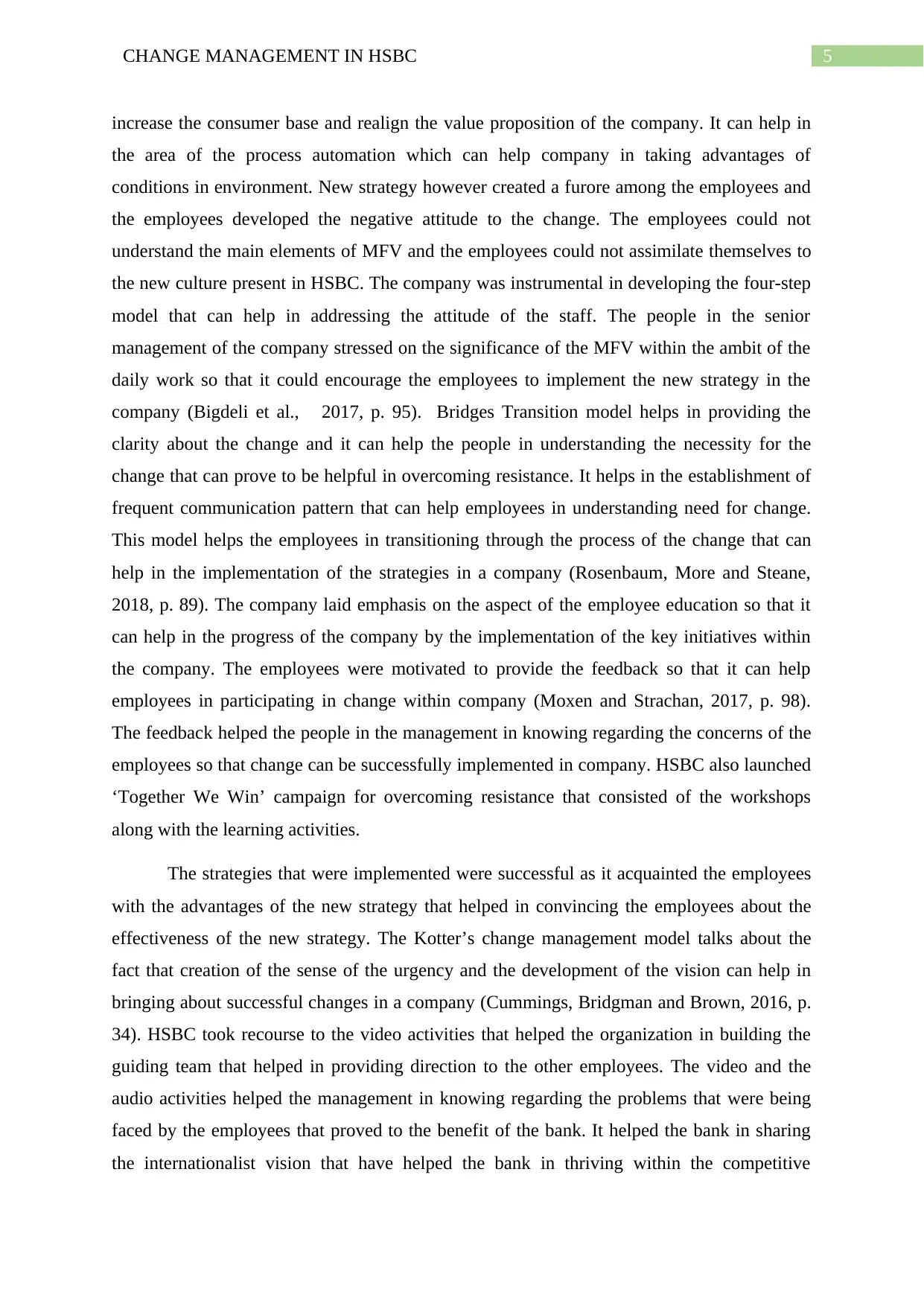
5CHANGE MANAGEMENT IN HSBC
increase the consumer base and realign the value proposition of the company. It can help in
the area of the process automation which can help company in taking advantages of
conditions in environment. New strategy however created a furore among the employees and
the employees developed the negative attitude to the change. The employees could not
understand the main elements of MFV and the employees could not assimilate themselves to
the new culture present in HSBC. The company was instrumental in developing the four-step
model that can help in addressing the attitude of the staff. The people in the senior
management of the company stressed on the significance of the MFV within the ambit of the
daily work so that it could encourage the employees to implement the new strategy in the
company (Bigdeli et al., 2017, p. 95). Bridges Transition model helps in providing the
clarity about the change and it can help the people in understanding the necessity for the
change that can prove to be helpful in overcoming resistance. It helps in the establishment of
frequent communication pattern that can help employees in understanding need for change.
This model helps the employees in transitioning through the process of the change that can
help in the implementation of the strategies in a company (Rosenbaum, More and Steane,
2018, p. 89). The company laid emphasis on the aspect of the employee education so that it
can help in the progress of the company by the implementation of the key initiatives within
the company. The employees were motivated to provide the feedback so that it can help
employees in participating in change within company (Moxen and Strachan, 2017, p. 98).
The feedback helped the people in the management in knowing regarding the concerns of the
employees so that change can be successfully implemented in company. HSBC also launched
‘Together We Win’ campaign for overcoming resistance that consisted of the workshops
along with the learning activities.
The strategies that were implemented were successful as it acquainted the employees
with the advantages of the new strategy that helped in convincing the employees about the
effectiveness of the new strategy. The Kotter’s change management model talks about the
fact that creation of the sense of the urgency and the development of the vision can help in
bringing about successful changes in a company (Cummings, Bridgman and Brown, 2016, p.
34). HSBC took recourse to the video activities that helped the organization in building the
guiding team that helped in providing direction to the other employees. The video and the
audio activities helped the management in knowing regarding the problems that were being
faced by the employees that proved to the benefit of the bank. It helped the bank in sharing
the internationalist vision that have helped the bank in thriving within the competitive
increase the consumer base and realign the value proposition of the company. It can help in
the area of the process automation which can help company in taking advantages of
conditions in environment. New strategy however created a furore among the employees and
the employees developed the negative attitude to the change. The employees could not
understand the main elements of MFV and the employees could not assimilate themselves to
the new culture present in HSBC. The company was instrumental in developing the four-step
model that can help in addressing the attitude of the staff. The people in the senior
management of the company stressed on the significance of the MFV within the ambit of the
daily work so that it could encourage the employees to implement the new strategy in the
company (Bigdeli et al., 2017, p. 95). Bridges Transition model helps in providing the
clarity about the change and it can help the people in understanding the necessity for the
change that can prove to be helpful in overcoming resistance. It helps in the establishment of
frequent communication pattern that can help employees in understanding need for change.
This model helps the employees in transitioning through the process of the change that can
help in the implementation of the strategies in a company (Rosenbaum, More and Steane,
2018, p. 89). The company laid emphasis on the aspect of the employee education so that it
can help in the progress of the company by the implementation of the key initiatives within
the company. The employees were motivated to provide the feedback so that it can help
employees in participating in change within company (Moxen and Strachan, 2017, p. 98).
The feedback helped the people in the management in knowing regarding the concerns of the
employees so that change can be successfully implemented in company. HSBC also launched
‘Together We Win’ campaign for overcoming resistance that consisted of the workshops
along with the learning activities.
The strategies that were implemented were successful as it acquainted the employees
with the advantages of the new strategy that helped in convincing the employees about the
effectiveness of the new strategy. The Kotter’s change management model talks about the
fact that creation of the sense of the urgency and the development of the vision can help in
bringing about successful changes in a company (Cummings, Bridgman and Brown, 2016, p.
34). HSBC took recourse to the video activities that helped the organization in building the
guiding team that helped in providing direction to the other employees. The video and the
audio activities helped the management in knowing regarding the problems that were being
faced by the employees that proved to the benefit of the bank. It helped the bank in sharing
the internationalist vision that have helped the bank in thriving within the competitive
⊘ This is a preview!⊘
Do you want full access?
Subscribe today to unlock all pages.

Trusted by 1+ million students worldwide
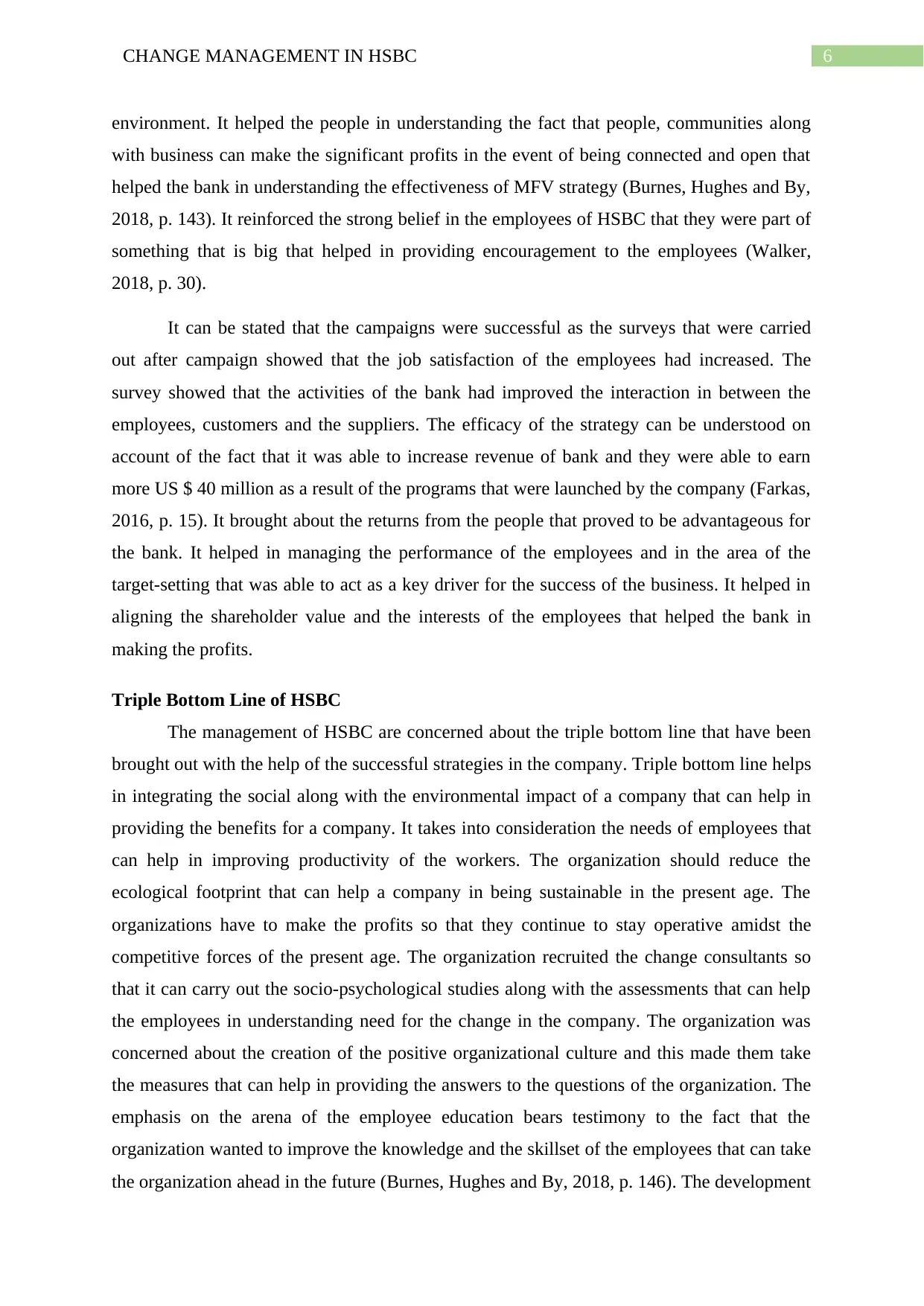
6CHANGE MANAGEMENT IN HSBC
environment. It helped the people in understanding the fact that people, communities along
with business can make the significant profits in the event of being connected and open that
helped the bank in understanding the effectiveness of MFV strategy (Burnes, Hughes and By,
2018, p. 143). It reinforced the strong belief in the employees of HSBC that they were part of
something that is big that helped in providing encouragement to the employees (Walker,
2018, p. 30).
It can be stated that the campaigns were successful as the surveys that were carried
out after campaign showed that the job satisfaction of the employees had increased. The
survey showed that the activities of the bank had improved the interaction in between the
employees, customers and the suppliers. The efficacy of the strategy can be understood on
account of the fact that it was able to increase revenue of bank and they were able to earn
more US $ 40 million as a result of the programs that were launched by the company (Farkas,
2016, p. 15). It brought about the returns from the people that proved to be advantageous for
the bank. It helped in managing the performance of the employees and in the area of the
target-setting that was able to act as a key driver for the success of the business. It helped in
aligning the shareholder value and the interests of the employees that helped the bank in
making the profits.
Triple Bottom Line of HSBC
The management of HSBC are concerned about the triple bottom line that have been
brought out with the help of the successful strategies in the company. Triple bottom line helps
in integrating the social along with the environmental impact of a company that can help in
providing the benefits for a company. It takes into consideration the needs of employees that
can help in improving productivity of the workers. The organization should reduce the
ecological footprint that can help a company in being sustainable in the present age. The
organizations have to make the profits so that they continue to stay operative amidst the
competitive forces of the present age. The organization recruited the change consultants so
that it can carry out the socio-psychological studies along with the assessments that can help
the employees in understanding need for the change in the company. The organization was
concerned about the creation of the positive organizational culture and this made them take
the measures that can help in providing the answers to the questions of the organization. The
emphasis on the arena of the employee education bears testimony to the fact that the
organization wanted to improve the knowledge and the skillset of the employees that can take
the organization ahead in the future (Burnes, Hughes and By, 2018, p. 146). The development
environment. It helped the people in understanding the fact that people, communities along
with business can make the significant profits in the event of being connected and open that
helped the bank in understanding the effectiveness of MFV strategy (Burnes, Hughes and By,
2018, p. 143). It reinforced the strong belief in the employees of HSBC that they were part of
something that is big that helped in providing encouragement to the employees (Walker,
2018, p. 30).
It can be stated that the campaigns were successful as the surveys that were carried
out after campaign showed that the job satisfaction of the employees had increased. The
survey showed that the activities of the bank had improved the interaction in between the
employees, customers and the suppliers. The efficacy of the strategy can be understood on
account of the fact that it was able to increase revenue of bank and they were able to earn
more US $ 40 million as a result of the programs that were launched by the company (Farkas,
2016, p. 15). It brought about the returns from the people that proved to be advantageous for
the bank. It helped in managing the performance of the employees and in the area of the
target-setting that was able to act as a key driver for the success of the business. It helped in
aligning the shareholder value and the interests of the employees that helped the bank in
making the profits.
Triple Bottom Line of HSBC
The management of HSBC are concerned about the triple bottom line that have been
brought out with the help of the successful strategies in the company. Triple bottom line helps
in integrating the social along with the environmental impact of a company that can help in
providing the benefits for a company. It takes into consideration the needs of employees that
can help in improving productivity of the workers. The organization should reduce the
ecological footprint that can help a company in being sustainable in the present age. The
organizations have to make the profits so that they continue to stay operative amidst the
competitive forces of the present age. The organization recruited the change consultants so
that it can carry out the socio-psychological studies along with the assessments that can help
the employees in understanding need for the change in the company. The organization was
concerned about the creation of the positive organizational culture and this made them take
the measures that can help in providing the answers to the questions of the organization. The
emphasis on the arena of the employee education bears testimony to the fact that the
organization wanted to improve the knowledge and the skillset of the employees that can take
the organization ahead in the future (Burnes, Hughes and By, 2018, p. 146). The development
Paraphrase This Document
Need a fresh take? Get an instant paraphrase of this document with our AI Paraphraser
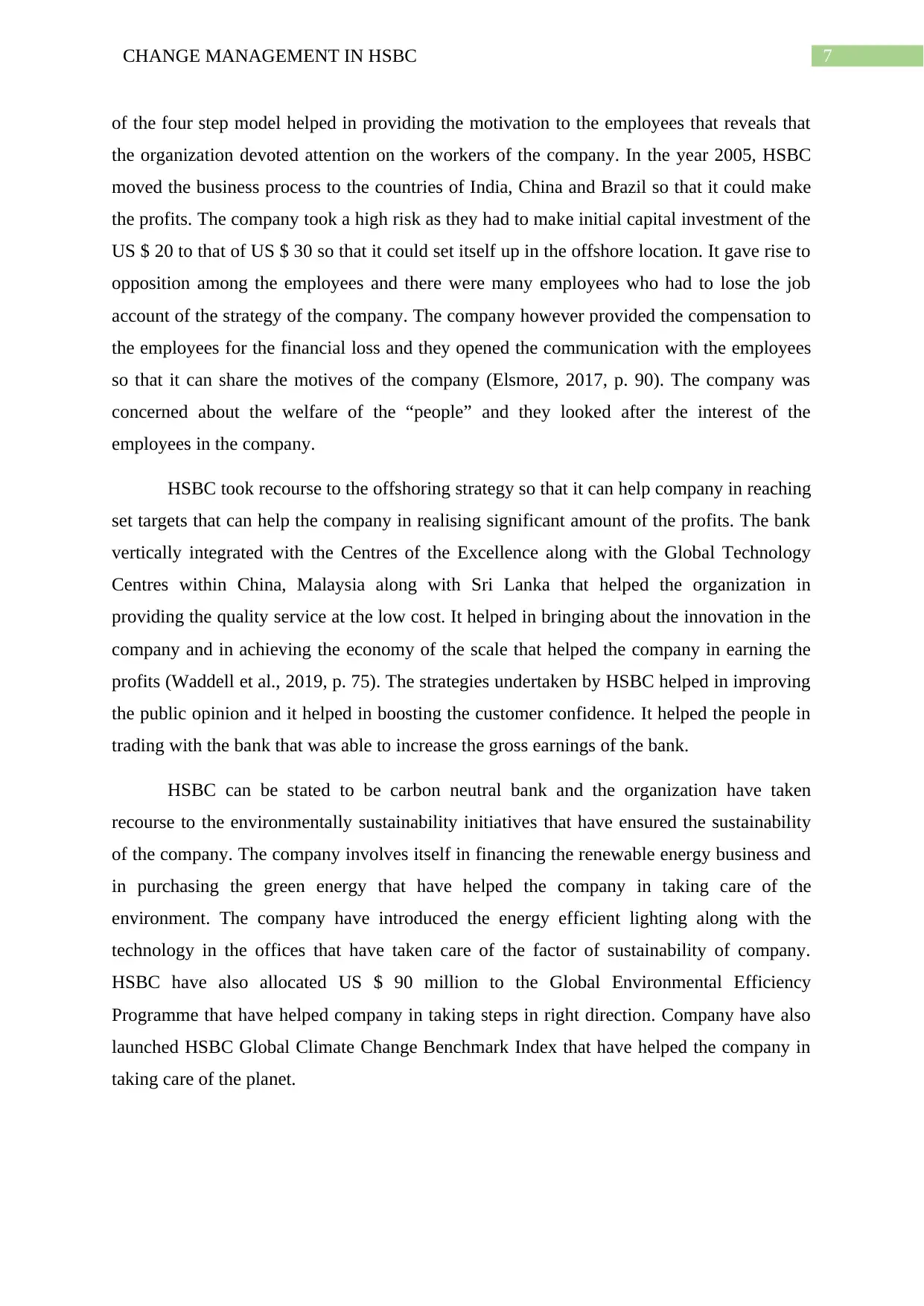
7CHANGE MANAGEMENT IN HSBC
of the four step model helped in providing the motivation to the employees that reveals that
the organization devoted attention on the workers of the company. In the year 2005, HSBC
moved the business process to the countries of India, China and Brazil so that it could make
the profits. The company took a high risk as they had to make initial capital investment of the
US $ 20 to that of US $ 30 so that it could set itself up in the offshore location. It gave rise to
opposition among the employees and there were many employees who had to lose the job
account of the strategy of the company. The company however provided the compensation to
the employees for the financial loss and they opened the communication with the employees
so that it can share the motives of the company (Elsmore, 2017, p. 90). The company was
concerned about the welfare of the “people” and they looked after the interest of the
employees in the company.
HSBC took recourse to the offshoring strategy so that it can help company in reaching
set targets that can help the company in realising significant amount of the profits. The bank
vertically integrated with the Centres of the Excellence along with the Global Technology
Centres within China, Malaysia along with Sri Lanka that helped the organization in
providing the quality service at the low cost. It helped in bringing about the innovation in the
company and in achieving the economy of the scale that helped the company in earning the
profits (Waddell et al., 2019, p. 75). The strategies undertaken by HSBC helped in improving
the public opinion and it helped in boosting the customer confidence. It helped the people in
trading with the bank that was able to increase the gross earnings of the bank.
HSBC can be stated to be carbon neutral bank and the organization have taken
recourse to the environmentally sustainability initiatives that have ensured the sustainability
of the company. The company involves itself in financing the renewable energy business and
in purchasing the green energy that have helped the company in taking care of the
environment. The company have introduced the energy efficient lighting along with the
technology in the offices that have taken care of the factor of sustainability of company.
HSBC have also allocated US $ 90 million to the Global Environmental Efficiency
Programme that have helped company in taking steps in right direction. Company have also
launched HSBC Global Climate Change Benchmark Index that have helped the company in
taking care of the planet.
of the four step model helped in providing the motivation to the employees that reveals that
the organization devoted attention on the workers of the company. In the year 2005, HSBC
moved the business process to the countries of India, China and Brazil so that it could make
the profits. The company took a high risk as they had to make initial capital investment of the
US $ 20 to that of US $ 30 so that it could set itself up in the offshore location. It gave rise to
opposition among the employees and there were many employees who had to lose the job
account of the strategy of the company. The company however provided the compensation to
the employees for the financial loss and they opened the communication with the employees
so that it can share the motives of the company (Elsmore, 2017, p. 90). The company was
concerned about the welfare of the “people” and they looked after the interest of the
employees in the company.
HSBC took recourse to the offshoring strategy so that it can help company in reaching
set targets that can help the company in realising significant amount of the profits. The bank
vertically integrated with the Centres of the Excellence along with the Global Technology
Centres within China, Malaysia along with Sri Lanka that helped the organization in
providing the quality service at the low cost. It helped in bringing about the innovation in the
company and in achieving the economy of the scale that helped the company in earning the
profits (Waddell et al., 2019, p. 75). The strategies undertaken by HSBC helped in improving
the public opinion and it helped in boosting the customer confidence. It helped the people in
trading with the bank that was able to increase the gross earnings of the bank.
HSBC can be stated to be carbon neutral bank and the organization have taken
recourse to the environmentally sustainability initiatives that have ensured the sustainability
of the company. The company involves itself in financing the renewable energy business and
in purchasing the green energy that have helped the company in taking care of the
environment. The company have introduced the energy efficient lighting along with the
technology in the offices that have taken care of the factor of sustainability of company.
HSBC have also allocated US $ 90 million to the Global Environmental Efficiency
Programme that have helped company in taking steps in right direction. Company have also
launched HSBC Global Climate Change Benchmark Index that have helped the company in
taking care of the planet.
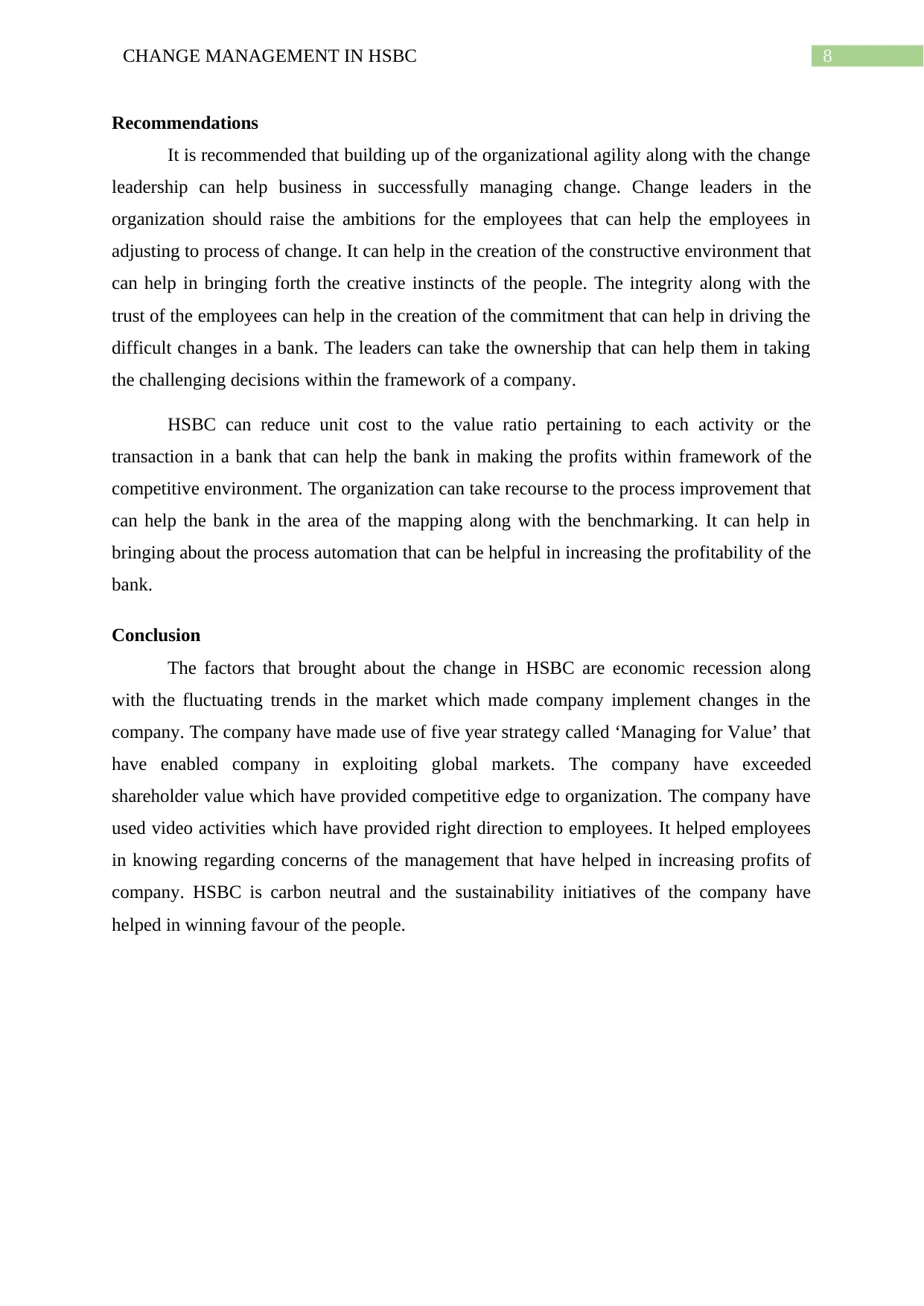
8CHANGE MANAGEMENT IN HSBC
Recommendations
It is recommended that building up of the organizational agility along with the change
leadership can help business in successfully managing change. Change leaders in the
organization should raise the ambitions for the employees that can help the employees in
adjusting to process of change. It can help in the creation of the constructive environment that
can help in bringing forth the creative instincts of the people. The integrity along with the
trust of the employees can help in the creation of the commitment that can help in driving the
difficult changes in a bank. The leaders can take the ownership that can help them in taking
the challenging decisions within the framework of a company.
HSBC can reduce unit cost to the value ratio pertaining to each activity or the
transaction in a bank that can help the bank in making the profits within framework of the
competitive environment. The organization can take recourse to the process improvement that
can help the bank in the area of the mapping along with the benchmarking. It can help in
bringing about the process automation that can be helpful in increasing the profitability of the
bank.
Conclusion
The factors that brought about the change in HSBC are economic recession along
with the fluctuating trends in the market which made company implement changes in the
company. The company have made use of five year strategy called ‘Managing for Value’ that
have enabled company in exploiting global markets. The company have exceeded
shareholder value which have provided competitive edge to organization. The company have
used video activities which have provided right direction to employees. It helped employees
in knowing regarding concerns of the management that have helped in increasing profits of
company. HSBC is carbon neutral and the sustainability initiatives of the company have
helped in winning favour of the people.
Recommendations
It is recommended that building up of the organizational agility along with the change
leadership can help business in successfully managing change. Change leaders in the
organization should raise the ambitions for the employees that can help the employees in
adjusting to process of change. It can help in the creation of the constructive environment that
can help in bringing forth the creative instincts of the people. The integrity along with the
trust of the employees can help in the creation of the commitment that can help in driving the
difficult changes in a bank. The leaders can take the ownership that can help them in taking
the challenging decisions within the framework of a company.
HSBC can reduce unit cost to the value ratio pertaining to each activity or the
transaction in a bank that can help the bank in making the profits within framework of the
competitive environment. The organization can take recourse to the process improvement that
can help the bank in the area of the mapping along with the benchmarking. It can help in
bringing about the process automation that can be helpful in increasing the profitability of the
bank.
Conclusion
The factors that brought about the change in HSBC are economic recession along
with the fluctuating trends in the market which made company implement changes in the
company. The company have made use of five year strategy called ‘Managing for Value’ that
have enabled company in exploiting global markets. The company have exceeded
shareholder value which have provided competitive edge to organization. The company have
used video activities which have provided right direction to employees. It helped employees
in knowing regarding concerns of the management that have helped in increasing profits of
company. HSBC is carbon neutral and the sustainability initiatives of the company have
helped in winning favour of the people.
⊘ This is a preview!⊘
Do you want full access?
Subscribe today to unlock all pages.

Trusted by 1+ million students worldwide
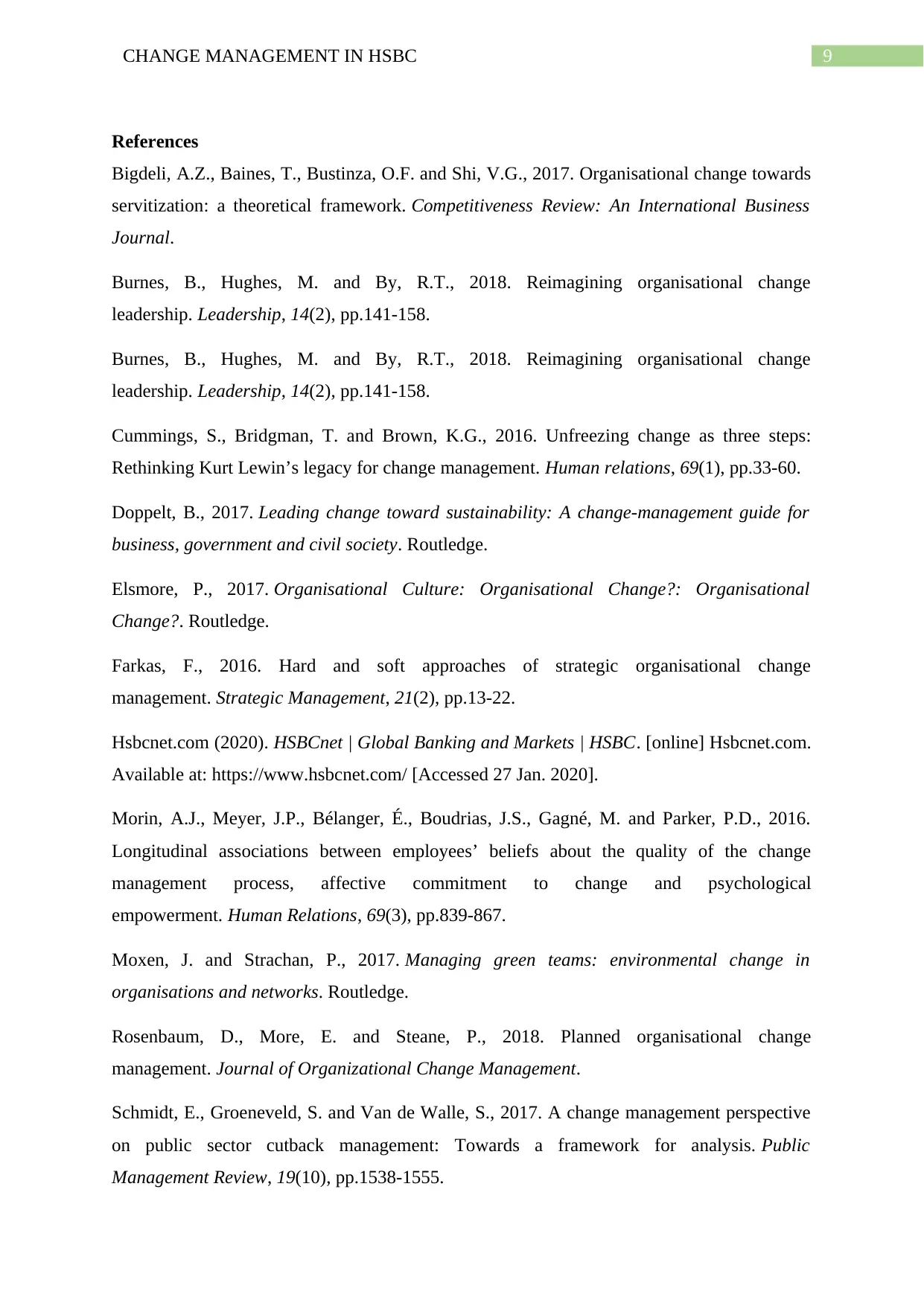
9CHANGE MANAGEMENT IN HSBC
References
Bigdeli, A.Z., Baines, T., Bustinza, O.F. and Shi, V.G., 2017. Organisational change towards
servitization: a theoretical framework. Competitiveness Review: An International Business
Journal.
Burnes, B., Hughes, M. and By, R.T., 2018. Reimagining organisational change
leadership. Leadership, 14(2), pp.141-158.
Burnes, B., Hughes, M. and By, R.T., 2018. Reimagining organisational change
leadership. Leadership, 14(2), pp.141-158.
Cummings, S., Bridgman, T. and Brown, K.G., 2016. Unfreezing change as three steps:
Rethinking Kurt Lewin’s legacy for change management. Human relations, 69(1), pp.33-60.
Doppelt, B., 2017. Leading change toward sustainability: A change-management guide for
business, government and civil society. Routledge.
Elsmore, P., 2017. Organisational Culture: Organisational Change?: Organisational
Change?. Routledge.
Farkas, F., 2016. Hard and soft approaches of strategic organisational change
management. Strategic Management, 21(2), pp.13-22.
Hsbcnet.com (2020). HSBCnet | Global Banking and Markets | HSBC. [online] Hsbcnet.com.
Available at: https://www.hsbcnet.com/ [Accessed 27 Jan. 2020].
Morin, A.J., Meyer, J.P., Bélanger, É., Boudrias, J.S., Gagné, M. and Parker, P.D., 2016.
Longitudinal associations between employees’ beliefs about the quality of the change
management process, affective commitment to change and psychological
empowerment. Human Relations, 69(3), pp.839-867.
Moxen, J. and Strachan, P., 2017. Managing green teams: environmental change in
organisations and networks. Routledge.
Rosenbaum, D., More, E. and Steane, P., 2018. Planned organisational change
management. Journal of Organizational Change Management.
Schmidt, E., Groeneveld, S. and Van de Walle, S., 2017. A change management perspective
on public sector cutback management: Towards a framework for analysis. Public
Management Review, 19(10), pp.1538-1555.
References
Bigdeli, A.Z., Baines, T., Bustinza, O.F. and Shi, V.G., 2017. Organisational change towards
servitization: a theoretical framework. Competitiveness Review: An International Business
Journal.
Burnes, B., Hughes, M. and By, R.T., 2018. Reimagining organisational change
leadership. Leadership, 14(2), pp.141-158.
Burnes, B., Hughes, M. and By, R.T., 2018. Reimagining organisational change
leadership. Leadership, 14(2), pp.141-158.
Cummings, S., Bridgman, T. and Brown, K.G., 2016. Unfreezing change as three steps:
Rethinking Kurt Lewin’s legacy for change management. Human relations, 69(1), pp.33-60.
Doppelt, B., 2017. Leading change toward sustainability: A change-management guide for
business, government and civil society. Routledge.
Elsmore, P., 2017. Organisational Culture: Organisational Change?: Organisational
Change?. Routledge.
Farkas, F., 2016. Hard and soft approaches of strategic organisational change
management. Strategic Management, 21(2), pp.13-22.
Hsbcnet.com (2020). HSBCnet | Global Banking and Markets | HSBC. [online] Hsbcnet.com.
Available at: https://www.hsbcnet.com/ [Accessed 27 Jan. 2020].
Morin, A.J., Meyer, J.P., Bélanger, É., Boudrias, J.S., Gagné, M. and Parker, P.D., 2016.
Longitudinal associations between employees’ beliefs about the quality of the change
management process, affective commitment to change and psychological
empowerment. Human Relations, 69(3), pp.839-867.
Moxen, J. and Strachan, P., 2017. Managing green teams: environmental change in
organisations and networks. Routledge.
Rosenbaum, D., More, E. and Steane, P., 2018. Planned organisational change
management. Journal of Organizational Change Management.
Schmidt, E., Groeneveld, S. and Van de Walle, S., 2017. A change management perspective
on public sector cutback management: Towards a framework for analysis. Public
Management Review, 19(10), pp.1538-1555.
Paraphrase This Document
Need a fresh take? Get an instant paraphrase of this document with our AI Paraphraser
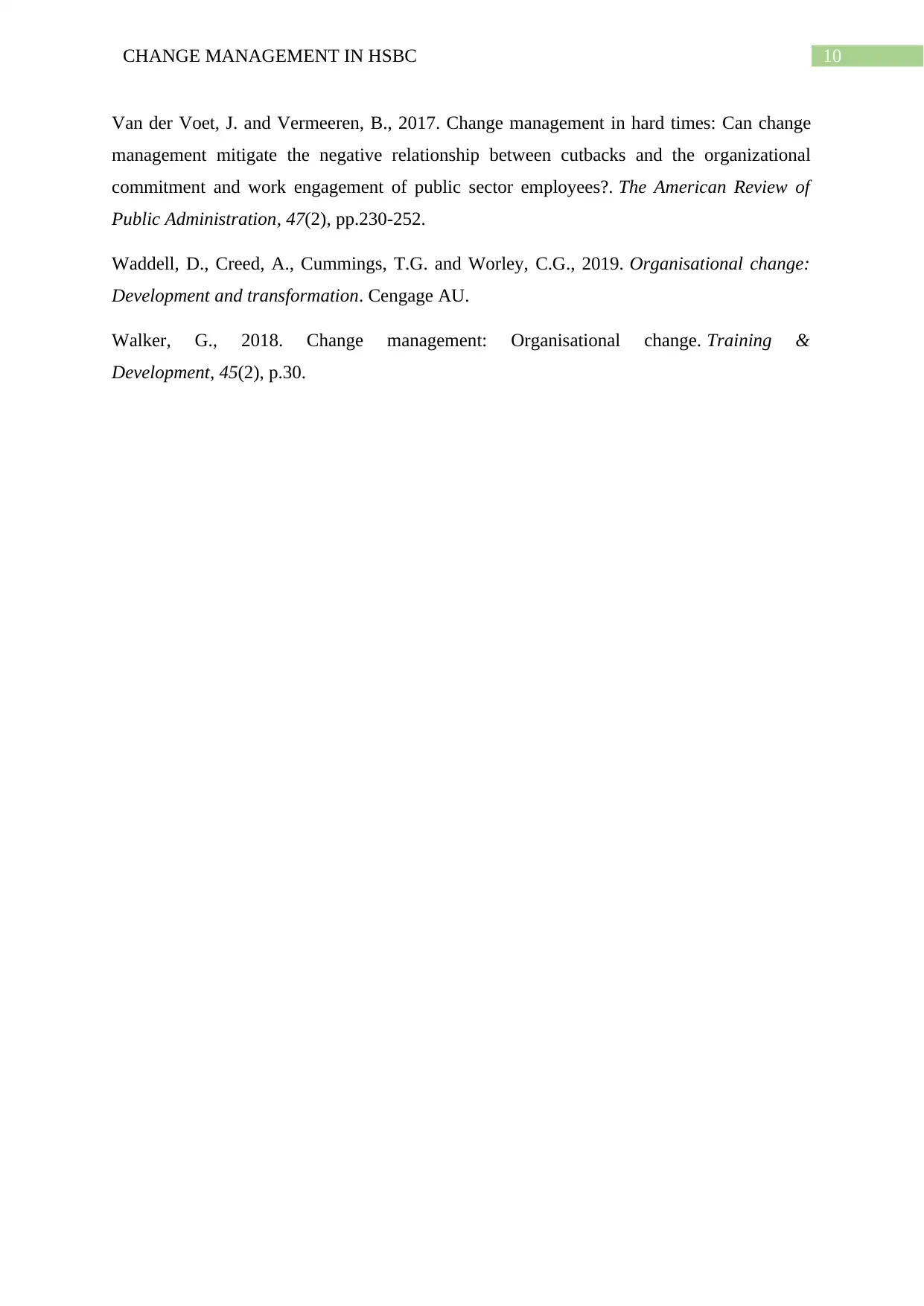
10CHANGE MANAGEMENT IN HSBC
Van der Voet, J. and Vermeeren, B., 2017. Change management in hard times: Can change
management mitigate the negative relationship between cutbacks and the organizational
commitment and work engagement of public sector employees?. The American Review of
Public Administration, 47(2), pp.230-252.
Waddell, D., Creed, A., Cummings, T.G. and Worley, C.G., 2019. Organisational change:
Development and transformation. Cengage AU.
Walker, G., 2018. Change management: Organisational change. Training &
Development, 45(2), p.30.
Van der Voet, J. and Vermeeren, B., 2017. Change management in hard times: Can change
management mitigate the negative relationship between cutbacks and the organizational
commitment and work engagement of public sector employees?. The American Review of
Public Administration, 47(2), pp.230-252.
Waddell, D., Creed, A., Cummings, T.G. and Worley, C.G., 2019. Organisational change:
Development and transformation. Cengage AU.
Walker, G., 2018. Change management: Organisational change. Training &
Development, 45(2), p.30.
1 out of 11
Related Documents
Your All-in-One AI-Powered Toolkit for Academic Success.
+13062052269
info@desklib.com
Available 24*7 on WhatsApp / Email
![[object Object]](/_next/static/media/star-bottom.7253800d.svg)
Unlock your academic potential
Copyright © 2020–2025 A2Z Services. All Rights Reserved. Developed and managed by ZUCOL.





